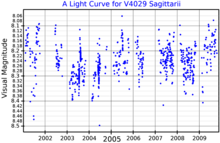HD 168607 (V4029 Sagittarii) is a blue hypergiant and luminous blue variable (LBV) star located in the constellation of Sagittarius, easy to see with amateur telescopes. It forms a pair with HD 168625, also a blue hypergiant and possible luminous blue variable, that can be seen at the south-east of M17, the Omega Nebula.
Physical properties

HD 168607 was estimated to be about as far away as is the Omega Nebula (2.2 kiloparsecs, 7,200 light years, from the Sun) and no respective measurements have been found that discount physical association with HD 168625.[10] Assuming this distance is correct, this star [11] is 240,000 times brighter than the Sun with a surface temperature of 9,300 K.[11] The Gaia Data Release 2 parallax of 0.6438±0.0603 mas implies a closer distance of about 1,500 pc.[12]
The apparent magnitude of this star or star system was observed to vary by 0.25 to 0.30 magnitudes with a period of 64 days when it was first identified as an α Cygni variable.[13] Unlike its neighbour HD 168625, no nebula has been found around this star.[14] It is classified in the General Catalogue of Variable Stars as a luminous blue variable or S Doradus variable with the variable star designation V4029 Sagittarii and a maximum and minimum visual magnitude of 8.12 and 8.29 respectively.[2] Although it is suspected of being in, or about to enter, an S Doradus phase, no outbursts have been observed.[13] A magnitude variation between 8.05 and 8.41 is reported from a broader range of observations.[15]
HD 168607 is thought to have had a mass between 25 and 30 M☉ when it first formed on the main sequence, but now much less.[13] Analysis of its period and photospheric abundances suggest that it has evolved through a red supergiant stage and has now expelled its outer atmosphere and increased its temperature again.[16]
References
- ^ a b Van Leeuwen, F. (2007). "Validation of the new Hipparcos reduction". Astronomy and Astrophysics. 474 (2): 653–664. arXiv:0708.1752. Bibcode:2007A&A...474..653V. doi:10.1051/0004-6361:20078357. S2CID 18759600.
- ^ a b Samus, N. N.; Durlevich, O. V.; et al. (2009). "VizieR Online Data Catalog: General Catalogue of Variable Stars (Samus+ 2007-2013)". VizieR On-line Data Catalog: B/GCVS. Originally Published in: 2009yCat....102025S. 1: B/gcvs. Bibcode:2009yCat....102025S.
- ^ Chentsov, E. L.; Ermakov, S. V.; Klochkova, V. G.; Panchuk, V. E.; Bjorkman, K. S.; Miroshnichenko, A. S. (2003). "An atlas of spectra of B6-A2 hypergiants and supergiants from 4800 to 6700Å" (PDF). Astronomy and Astrophysics. 397 (3): 1035–1042. Bibcode:2003A&A...397.1035C. doi:10.1051/0004-6361:20021430.
- ^ a b c Ducati, J. R. (2002). "VizieR Online Data Catalog: Catalogue of Stellar Photometry in Johnson's 11-color system". CDS/ADC Collection of Electronic Catalogues. 2237: 0. Bibcode:2002yCat.2237....0D.
- ^ Nazé, Y.; Rauw, G.; Hutsemékers, D. (2012). "The first X-ray survey of Galactic luminous blue variables". Astronomy & Astrophysics. 538: A47. arXiv:1111.6375. Bibcode:2012A&A...538A..47N. doi:10.1051/0004-6361/201118040. S2CID 43688343.
- ^ Kharchenko, N. V.; Scholz, R.-D.; Piskunov, A. E.; Röser, S.; Schilbach, E. (2007). "Astrophysical supplements to the ASCC-2.5: Ia. Radial velocities of ˜55000 stars and mean radial velocities of 516 Galactic open clusters and associations". Astronomische Nachrichten. 328 (9): 889. arXiv:0705.0878. Bibcode:2007AN....328..889K. doi:10.1002/asna.200710776. S2CID 119323941.
- ^ a b Brown, A. G. A.; et al. (Gaia collaboration) (August 2018). "Gaia Data Release 2: Summary of the contents and survey properties". Astronomy & Astrophysics. 616. A1. arXiv:1804.09365. Bibcode:2018A&A...616A...1G. doi:10.1051/0004-6361/201833051. Gaia DR2 record for this source at VizieR.
- ^ a b c d e Van Genderen, A. M.; Van Den Bosch, F. C.; Dessing, F.; Fehmers, G. C.; Van Grunsven, J.; Van Der Heiden, R.; Janssens, A. M.; Kalter, R.; Van Der Meer, R. L. J.; Van Ojik, R.; Smit, J. M.; Zijderveld, M. J. (1992). "Light variations of massive stars (Alpha Cygni variables). XIII - the B-type hypergiants R81 (LBV), HD 80077 (LBV?), HD 168607 = V 4029 Sagittarii (LBV) and HD 168625 = V 4030 Sagittarii". Astronomy and Astrophysics. 264: 88. Bibcode:1992A&A...264...88V.
- ^ "ASAS All Star Catalogue". The All Sky Automated Survey. Retrieved 8 December 2021.
- ^ Chentsov, E.L.; Gorda, E.S. (2004). "Spatial Closeness of the White Hypergiants HD 168607 and HD 168625". Astronomy Letters. 30 (7): 145–180. Bibcode:2004AstL...30..461C. doi:10.1134/1.1774398. S2CID 122348932.
- ^ a b van Genderen, A.M. (2001). "S Doradus variables in the Galaxy and the Magellanic Clouds". Astronomy & Astrophysics. 366 (2): 508–531. Bibcode:2001A&A...366..508V. doi:10.1051/0004-6361:20000022.
- ^ Bailer-Jones, C. A. L.; Rybizki, J.; Fouesneau, M.; Mantelet, G.; Andrae, R. (2018). "Estimating Distance from Parallaxes. IV. Distances to 1.33 Billion Stars in Gaia Data Release 2". The Astronomical Journal. 156 (2): 58. arXiv:1804.10121. Bibcode:2018AJ....156...58B. doi:10.3847/1538-3881/aacb21. S2CID 119289017.
- ^ a b c Sterken, C.; Arentoft, T.; Duerbeck, H.W.; Brogt, E. (1999). "Light variations of the blue hypergiants HD 168607 and HD 168625 (1973-1999)". Astronomy & Astrophysics. 349: 532–536. Bibcode:1999A&A...349..532S.
- ^ Hutsemekers, D.; vanDrom, E.; Gosset, E.; Melnick, J. (1994). "A dusty nebula around the luminous blue variable candidate HD 168625". Astronomy and Astrophysics. 2904: 906–914. Bibcode:1994A&A...290..906H.
- ^ "V4029 Sgr". International Variable Star Index. Retrieved 2021-01-05.
- ^ Saio, Hideyuki; Georgy, Cyril; Meynet, Georges (2013). "Evolution of blue supergiants and α Cygni variables: Puzzling CNO surface abundances". Monthly Notices of the Royal Astronomical Society. 433 (2): 1246–1257. arXiv:1305.2474. Bibcode:2013MNRAS.433.1246S. doi:10.1093/mnras/stt796. S2CID 119295289.


Recent Comments